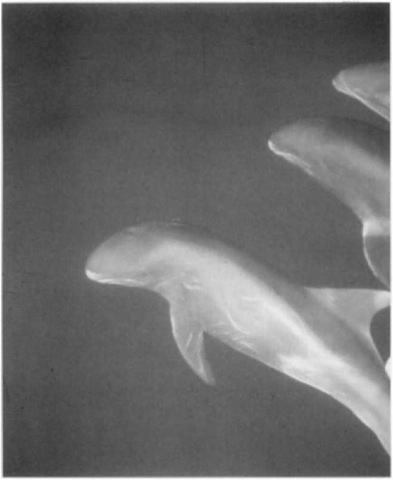Although called by the common name “whale,” the pygmy killer whale, like its close relative, the killer whale, belongs taxonomically to the dolphin family, Delphinidae. Until 1952 this species was only known from two skulls collected in the 19th century. Since that time, a number of specimens have been collected from strandings and fishery catches around the world, yet the pygmy killer whale remains one of the least known of the small cetaceans.
I. Characters and Taxonomic Relationship
The pygmy killer whale has a moderately robust body that narrows posteriorly to the dorsal fin, hence the name attenuata from the Latin “to make thin or taper” (Fig. 1). The head is round and blunt and lacks a beak typical of many dolphin species. The head does not narrow or appear triangular when viewed from above as with the melon-headed whale (Pepono-cephala electro). The moderately long flippers are rounded at the tips with convex leading and concave trailing edges.
On the back and portions of the flanks and ventral surface, the pygmy killer whale is dark gray to black. A subtle, dark cape (an area of coloration extending from the forehead past the dorsal fin) is present, which extends the greatest distance down the side of the animal below the high, falcate dorsal fin. A paler gray area on each flank is usually present from the tail stock to the eye. On its ventral side, the pygmy killer has an irregularly shaped white patch between the flippers, around the genitals, and occasionally on the tail stock. The lips are also edged with white.
The skull is broad and robust. The upper and lower jaws have less than 15 teeth each, a character that distinguishes the pygmy killer whale from the melon-headed whale, which typically has more than 20 teeth per row.
Length measurements from several specimens average 2.31 m (range 2.14-2.59 m). Differences in lengths between males and females have not been observed in measured specimens.
II. Distribution and Ecology
Pygmy killer whales have been recorded in tropical and subtropical waters worldwide. Sightings have been relatively frequent in the eastern tropical Pacific, the Hawaiian Archipelago and off Japan. The migratory status of this species cannot be determined based on available information. However, incidental catches and observations by fishermen suggest that this species is a year-round resident at least in the regions of Sri Lanka and the Lesser Antilles.
Figure 1 Pygmy killer whale.
Although the feeding habits of pygmy killer whales are not well known, remnants of cephalopods and small fish have been found in specimens from strandings and incidental fishery catches.
III. Life History and Behavior
Little is known about this species’ growth, reproduction, or social organization. An estimated length at sexual maturity of 2 m based on 85% of the mean length at physical maturity (Laws, 1956) is consistent with data collected from three sexually mature males ranging in length from 2.07 to 2.61 m and three pregnant females ranging in length from 2.20 to 2.27 m. Pygmy killer whales are found most commonly in small herds, ranging from 12 to 50 animals, although herds of 100 or more have been encountered. This species has been observed bow riding, performing high leafs, and “spyhopping” (raising the head vertically out of the water).
Pygmy killer whales are suspected to be among the small whales that chase, attack, and sometimes eat dolphins (Stenella spp. and Delphinus delphis) involved in the purse seine fishery for yellowfin tuna in the eastern tropical Pacific (Perryman and Foster, 1980). Aggressive behavior has also been observed by two pygmy killer whales in captivity in Hawaii and South Africa, but a herd captured off Japan showed no such aggression when placed in an enclosure with other dolphins.
IV. Conservation Status
Although they are not considered rare, the population size and structure of the pygmy killer whale are not known. Between 1986 and 1990, five research vessel surveys were conducted in the eastern tropical Pacific and an abundance of 38,900 (CV = 0.305) pygmy killer whales was estimated for that area (Wade and Gerrodette, 1993).
Pygmy killer whales have been caught directly and incidentally in fisheries. Small cetacean fisheries in St. Vincent and Indonesia have been known to catch pygmy killer whales, but they comprise a small proportion of the catch and these catches are thought to have little effect on the population in those areas. Monitoring of fisheries in which pygmy killer whales are caught incidentally has not been extensive. Mortality in these fisheries, such as those around Sri Lanka, could be greater than that documented and may have a significant impact on pygmy killer whale stocks in those regions. In Sri Lanka, pygmy killer whales have also been harpooned and used as bait in long-line fisheries for sharks, billfish, and other oceanic fishes (Leather-wood and Reeves, 1989).

